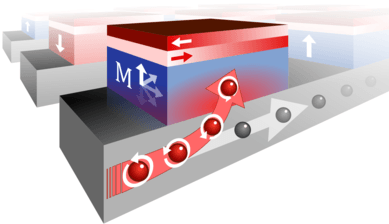Current bending yields low-power magnetic memory
March 10, 2016
on
on

Magnetic random-access memory (MRAM) is faster, more efficient and more robust than other data storage media. MRAM stores data by making clever use of electron spin – a sort of gyroscopic property of electrons. Because it used magnetism instead of stored charge, MRAM is nonvolatile, which means that the stored data can survive a power outage. MRAM also uses much less current. However, high peak currents are necessary to flip the electron spins in the right direction to store the data.
Physicists at Eindhoven University (TU/e) have developed an innovative technique for flipping the magnetic bits faster and with less power. They send a current pulse beneath the bit cell, causing the electrons with the right spin to bend upward through the bit cell. The new memory is very fast, but it needs a magnetic field for reliable operation. The researchers solved this by placing a layer of a special anti-ferromagnetic material on top of the bit cells.
Physicists at Eindhoven University (TU/e) have developed an innovative technique for flipping the magnetic bits faster and with less power. They send a current pulse beneath the bit cell, causing the electrons with the right spin to bend upward through the bit cell. The new memory is very fast, but it needs a magnetic field for reliable operation. The researchers solved this by placing a layer of a special anti-ferromagnetic material on top of the bit cells.
Read full article
Hide full article


Discussion (0 comments)